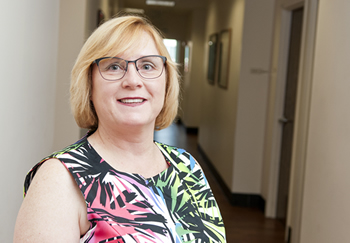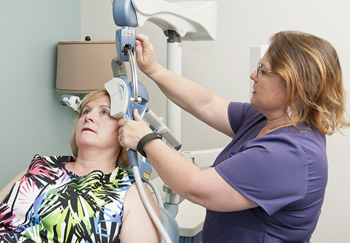Imagine waking up sad, down, emotionally exhausted. Depression. Some form of it has probably happened to you before. Your hopes feel hopeless, your soul feels lonely, and while these feelings may originate in a life event — a death, a divorce, job pressure — this awful feeling of doom and despair colors everything.
 Now imagine waking up like this, every day, for 22 years.
Now imagine waking up like this, every day, for 22 years.
Depressive episodes affect more people than you’d think. According to the National Network of Depression Centers, about one in five Americans has firsthand experience with depression, bipolar illness or other mood disorder.
For most of the people, depression has a temporary shelf life — or can be managed with talk therapy and/or antidepressants.
But standard treatments for depression don’t work for everyone. In fact, for about a third of people diagnosed with depression, treatments don’t work at all.
A Lifetime of Depression
Such was the case for Karen Pfeiffer. Now 50 years old, she remembers depression as a major factor in her life since she was 12. She attempted suicide twice in middle and high school. Although group counseling at college helped her survive, the symptoms never got resolved. The diagnosis: A major depressive disorder.
After college, she followed a fairly normal trajectory: She got married and started a family.
But Karen’s inner life was anything but normal.
“At times,” she recalls, “it was almost debilitating. It was hard to get out of bed to do things. I gained excessive amounts of weight. It was hard to do anything. I had trouble sleeping; and when I was dreaming, it would usually turn into a nightmare.”
Circumstances made finding support challenging. “We moved 15 times throughout my husband’s career in the Air Force. Every time we would move I would have to completely pack up my world and move to the next place. He would always have co-workers to associate with, and the children had school; but I didn’t have a support group, and every time I started one it was pulled out from beneath me. It was a trigger” that sent her repeatedly into deepening depression.
And medications failed to help. “I was treated with, you name it, every kind of depression medication,” she says. “What was common about the medications: They either didn’t do anything and I couldn’t feel anything, or they made me feel like a zombie, kind of numb, and I would quit taking the medication altogether.”
And nothing was changing. Now living in Charlottesville and working as a mobile radiographer — giving X-rays to people living at nursing homes, rehab facilities, prisons, jails, private homes — Karen found herself with “a job where I’m out by myself every day; I do 500 miles weekly in my vehicle. And I thought to myself, if I’m in an accident and I don’t live — that will be ok. That way, I’m not committing suicide, but I’m not suffering anymore.”

Some Type of Hope
Then one day in the car, Karen heard a story on National Public Radio “about people who had suffered from different types of mental illness, not necessarily depression, talking about this therapy and how it had changed their life. It really sounded like something that, if it were in this area, it would give me some type of hope.”
She talked to her primary care doctor and found out that transcranial magnetic stimulation (TMS) therapy was indeed here, at UVA. She was referred for an evaluation to see if she was a candidate for the treatment.
“I tried to go in with as positive attitude as I could,” Karen says. “I knew it could work or it could just be one more thing that didn’t.”
When David Hamilton, MD, told Karen that yes, she was approved to try TMS, “I was happy but kind of scared. It’s different than taking medicine or sitting with a group. I didn’t know what to expect.”
After a glitch with insurance — at first they weren’t going to cover it, but UVA helped get Karen approved — she was scheduled right away.
Karen took that as a good sign. “That alone has to be good news; a sign that something great’s going to happen.”
What is TMS Therapy?
FDA-approved and drug-free, TMS uses electrical currents and magnetic pulses to stimulate nerve cells in your brain and lessen depression.
Unlike antidepressants, which enter the bloodstream and can cause side effects throughout the body, TMS therapy directly targets the specific parts of the brain responsible for regulating mood.
TMS therapy specifically benefits people who previously tried antidepressants, with little success.
The Treatment Experience
Even though Hamilton had explained the mechanics of TMS, and Karen had read several stories by other patients who had done the therapy, she still wasn’t completely prepared for what the treatment was like.
“If you’ve never been on a roller coaster before and someone told you what it was like, even if you read a story or saw a film of what it was like, it’s still not going to prepare you for the way you feel when you go on it,” Karen explains.
“That very first time, they had it one notch below the normal treatment level, and I wanted to cry. It felt like a jackhammer on my teeth from the top of my skull: a 9.5 on a pain scale of 0-10. I didn’t know if I was going to be able to go through with it. I got a cotton wool feeling that made my head foggy that stayed with me the rest of the day.”
But Karen didn’t want to give up just yet. “I need to try for a little bit longer,” she told herself. The second time she went in for therapy, the cotton wool feeling only lasted for 30 minutes, and the pain was much less.
“By the end of the first week, I was able to tolerate it pretty well,” she says. “After about 7 or 8 treatments, I was down to a 2 pain level.”
A few weeks in, and Karen doesn’t “even notice that it’s there. I don’t hear it or feel it or anything. At this point, I don’t even notice it; the jackhammer is now a tapping.”
A New Adventure
Standard TMS therapy usually lasts 4-6 weeks, consisting of daily sessions for five days a week, each about 37 minutes. Doctors expect to see mood improvements anywhere from 2-3 weeks.
Karen was right on schedule.
“About 2.5 weeks into the treatment, I woke up getting ready to go to my treatment and I could feel myself grinning. The whole day I had a stupid smile on my face. For years I have always worried about what people thought of me; that day, it didn’t bother me anymore. Almost a giddy feeling.”
Before the therapy, Karen would do anything to avoid talking to people. “I would walk slower, so people wouldn’t notice me. Now, I find myself engaging in conversation with people and doing little things like going out of my way to hold the door for someone. Getting out of bed in the morning is almost an adventure.”
Do You Have Depression?
Watch this video about TMS therapy.
Karen says her family and friends notice the change, too. “I ran into friends of mine from school I hadn’t seen in a year, and they said, ‘Wow, you look terrific! How are you doing?’ and I could honestly say, ‘I’m doing really well.’ I started getting phone calls from friends, and everything seems to be going somewhat smoother, somewhat happier.”
As she faces her last full week of TMS, Karen has already been allowed to stop taking any medication for depression. She’s sleeping better: “I’ve been getting up regularly every day after sleeping very soundly with very pleasant dreams. Feeling positive emotionally is making me feel better physically; it spills into everything else.”
“I don’t know what’s going to happen to me,” she says, with excitement, acknowledging that some patients do end up needing a few touch-up treatments later on. “But whatever happens is a lot more hopeful than I’ve had in the past.”
To anyone trying TMS therapy, Karen says this: “Stick with it. Your life will change.”


I have had agoraphobia with panic attacks for approx. 35 years. Been on so many medications for this condition, and still being treated for this. I’m much better than I was first diagnosed. I still cannot drive long distances by myself. Can drive some places close to home by myself. Still on medications and go to Psychiatry mostly for medications. I’m 69 years old, maybe too old to do anything. Read about TMS and just wonder if this could help me, would like to learn how to go on an airplane, and to go places by myself. Thanks
Hi Karen, Thanks for your comment and question. At this time, the FDA has approved TMS therapy only for depression.